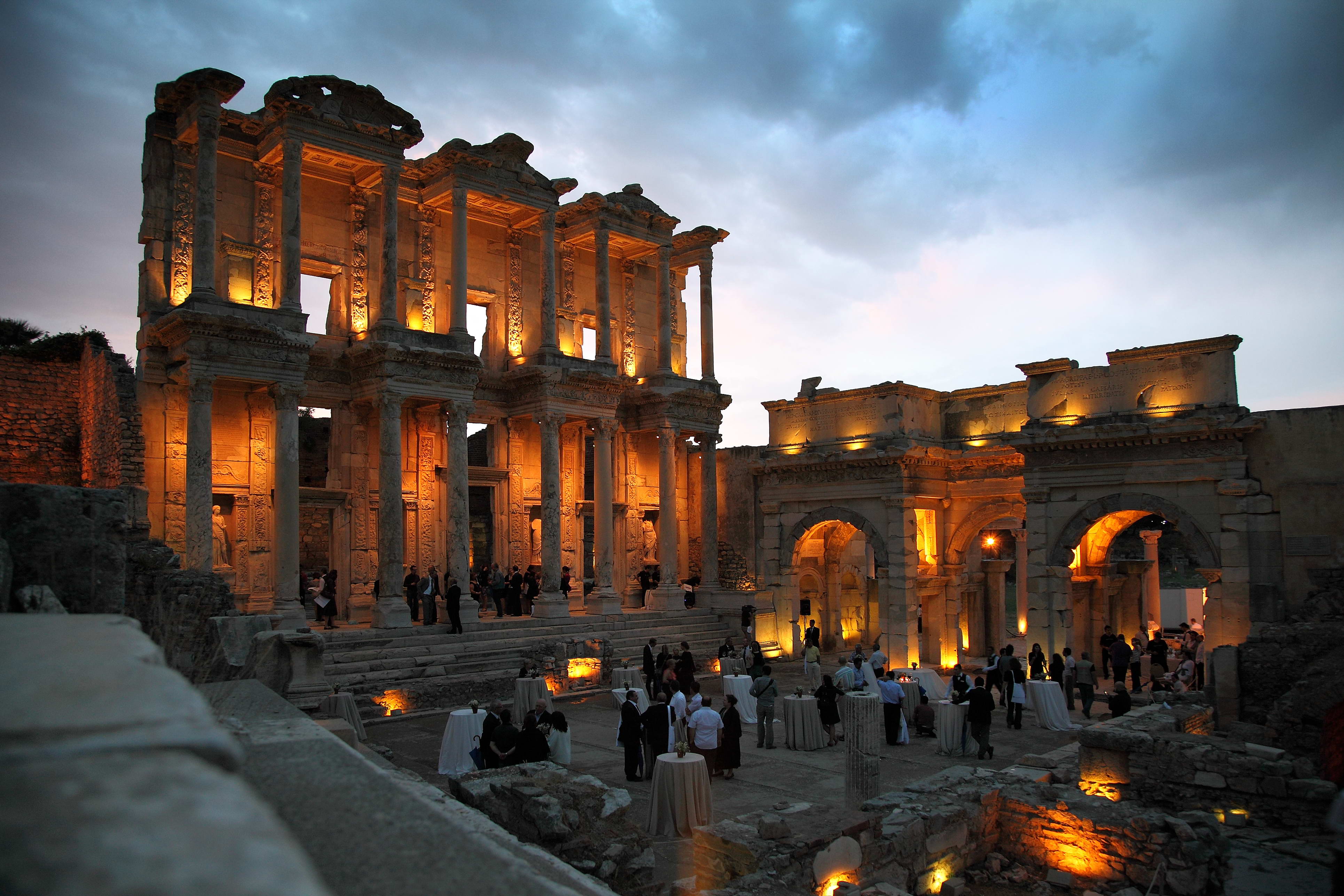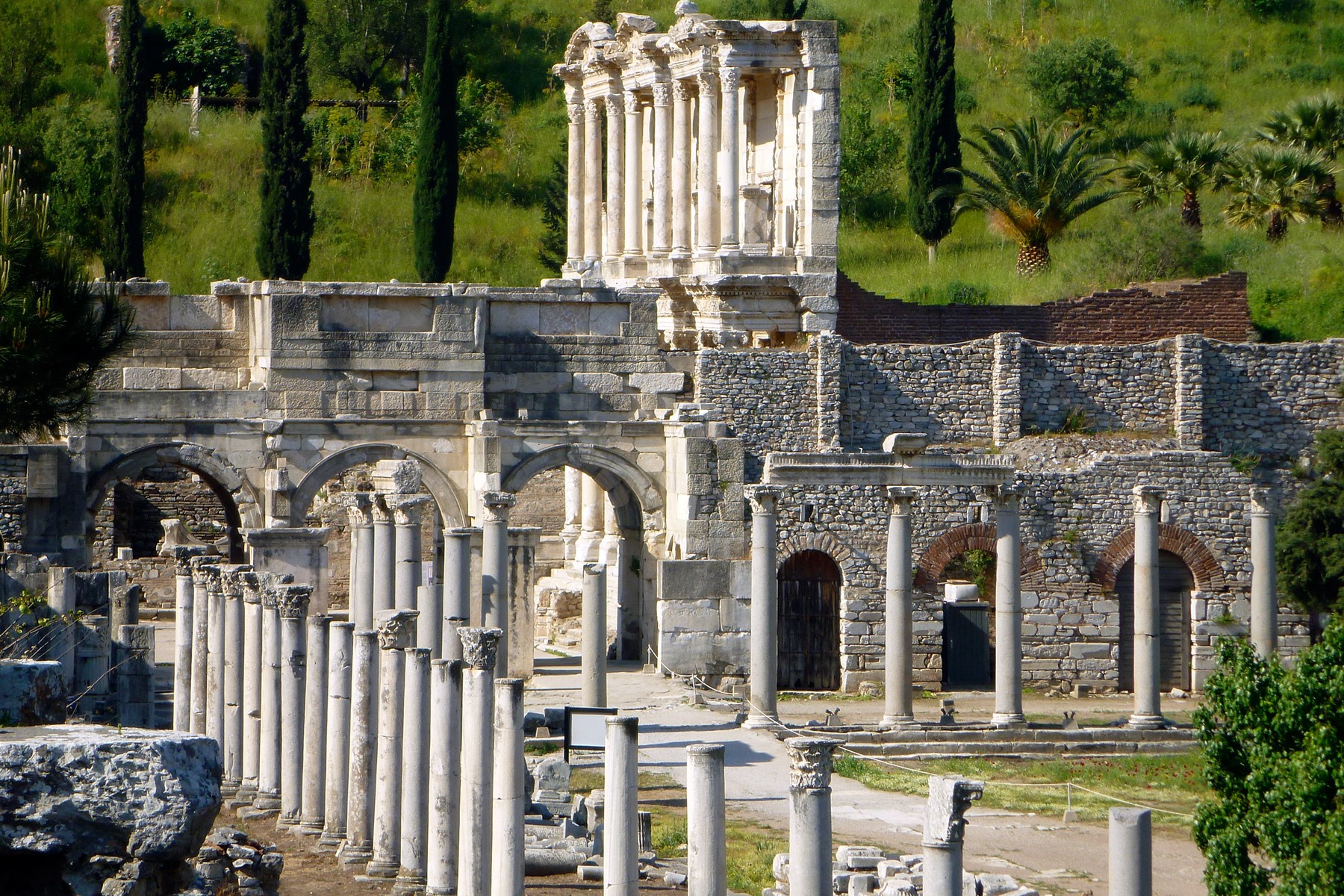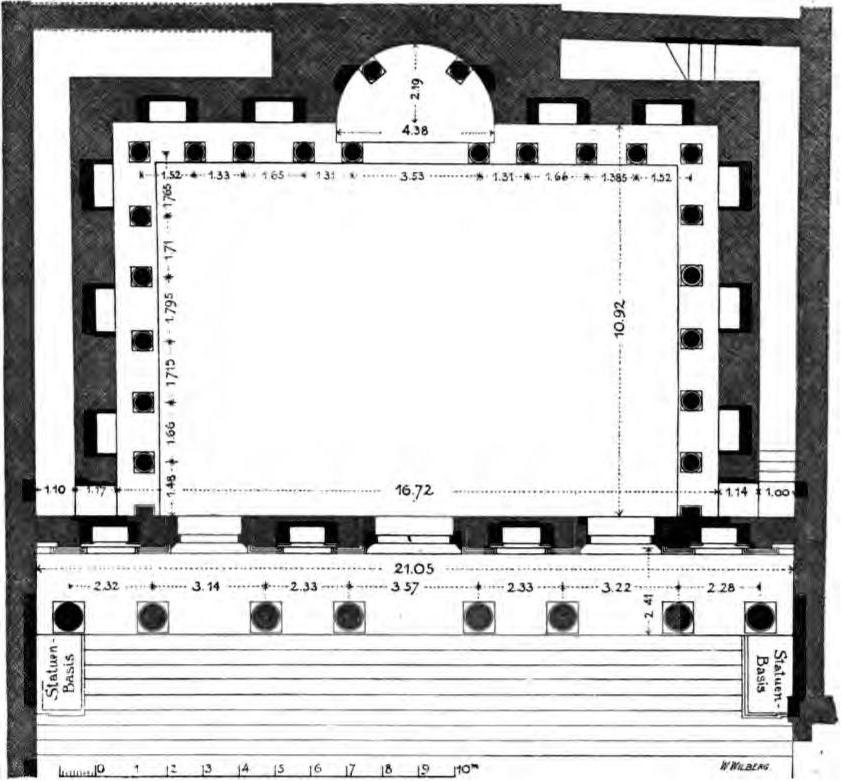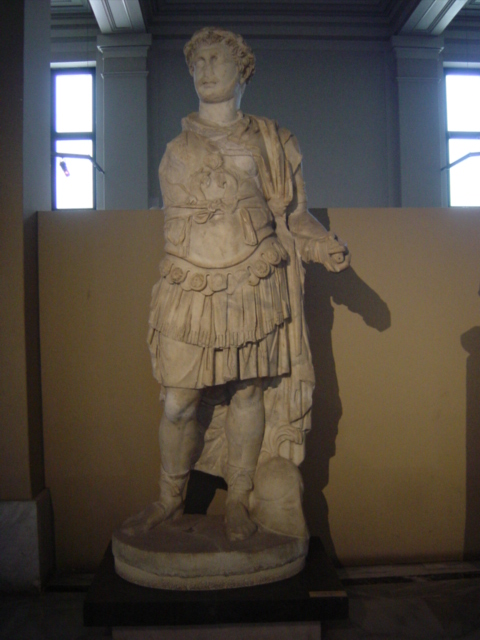Library of Celsus on:
[Wikipedia]
[Google]
[Amazon]

 The Library of Celsus ( el, Βιβλιοθήκη του Κέλσου) is an ancient Roman building in
The Library of Celsus ( el, Βιβλιοθήκη του Κέλσου) is an ancient Roman building in
 The library operated as a public space for the city from its completion around 117–135 A.D. until 262. The main floor functioned as a reading room, lit by abundant natural light from the eastern windows. Shelves or ''
The library operated as a public space for the city from its completion around 117–135 A.D. until 262. The main floor functioned as a reading room, lit by abundant natural light from the eastern windows. Shelves or '' The interior and contents of the library were destroyed by fire in 262 C.E., though it remains unknown whether this fire was the result of natural disaster or a Gothic invasion, as it seems the city was struck by one of each that year. Only the façade survived, until an earthquake in eleventh or tenth century left it in ruins as well.
The interior and contents of the library were destroyed by fire in 262 C.E., though it remains unknown whether this fire was the result of natural disaster or a Gothic invasion, as it seems the city was struck by one of each that year. Only the façade survived, until an earthquake in eleventh or tenth century left it in ruins as well. Between 1970 and 1978, a reconstruction campaign was led by the German archaeologist Volker Michael Strocka. Strocka analysed the fragments that had been excavated by Austrian archaeologists between 1903 and 1904. In the meantime, some of the architectural elements had been acquired by museums in Vienna and Istanbul. The absent fragments had to be replaced by copies or left missing. Only the façade was rebuilt, while the rest of the building remains in ruin.
Between 1970 and 1978, a reconstruction campaign was led by the German archaeologist Volker Michael Strocka. Strocka analysed the fragments that had been excavated by Austrian archaeologists between 1903 and 1904. In the meantime, some of the architectural elements had been acquired by museums in Vienna and Istanbul. The absent fragments had to be replaced by copies or left missing. Only the façade was rebuilt, while the rest of the building remains in ruin.
 The east-facing marble façade of the library is intricately decorated with botanical carvings and portrait statuary. The facade on the outside was built with false perspective, a Greek technique. This means that the inside columns are longer while the outside columns are higher. Though the columns are not identical, the illusion is that they are. This makes the library look larger on the outside and more grand than it actually is. Design features include acanthus leaves, scrolls, and
The east-facing marble façade of the library is intricately decorated with botanical carvings and portrait statuary. The facade on the outside was built with false perspective, a Greek technique. This means that the inside columns are longer while the outside columns are higher. Though the columns are not identical, the illusion is that they are. This makes the library look larger on the outside and more grand than it actually is. Design features include acanthus leaves, scrolls, and
Central Bank of the Republic of Turkey
. Banknote Museum: 8. Emission Group - Twenty New Turkish Lira
.
, 8 May 2007. – Retrieved on 20 April 2009.
classics.uc.edu
Architecture, classical studies, bibliography (Archived)
Virtual reconstruction of the Celsus library in Ephesus, Turkey
{{Authority control Ancient libraries Ancient Roman buildings and structures in Turkey Ephesus 135 Buildings and structures completed in the 2nd century Buildings and structures demolished in the 3rd century Defunct libraries Libraries in Turkey

 The Library of Celsus ( el, Βιβλιοθήκη του Κέλσου) is an ancient Roman building in
The Library of Celsus ( el, Βιβλιοθήκη του Κέλσου) is an ancient Roman building in Ephesus
Ephesus (; grc-gre, Ἔφεσος, Éphesos; tr, Efes; may ultimately derive from hit, 𒀀𒉺𒊭, Apaša) was a city in ancient Greece on the coast of Ionia, southwest of present-day Selçuk in İzmir Province, Turkey. It was built i ...
, Anatolia
Anatolia, tr, Anadolu Yarımadası), and the Anatolian plateau, also known as Asia Minor, is a large peninsula in Western Asia and the westernmost protrusion of the Asian continent. It constitutes the major part of modern-day Turkey. The re ...
, now part of Selçuk
Selçuk is a town in İzmir Province in the Aegean Region of Turkey. It is located northeast of the ancient city of Ephesus, that was once home to the Temple of Artemis, one of the Seven Wonders of the Ancient World.
Its previous Greek name, ...
, Turkey
Turkey ( tr, Türkiye ), officially the Republic of Türkiye ( tr, Türkiye Cumhuriyeti, links=no ), is a transcontinental country located mainly on the Anatolian Peninsula in Western Asia, with a small portion on the Balkan Peninsula ...
. The building was commissioned in the 110s A.D. by a consul
Consul (abbrev. ''cos.''; Latin plural ''consules'') was the title of one of the two chief magistrates of the Roman Republic, and subsequently also an important title under the Roman Empire. The title was used in other European city-states throu ...
, Gaius Julius Aquila, as a funerary monument for his father, former proconsul
A proconsul was an official of ancient Rome who acted on behalf of a consul. A proconsul was typically a former consul. The term is also used in recent history for officials with delegated authority.
In the Roman Republic, military command, or ' ...
of Asia Tiberius Julius Celsus Polemaeanus
Tiberius Julius Celsus Polemaeanus ( el, Τιβέριος Ἰούλιος Κέλσος Πολεμαιανός, translit=Tibérios Ioúlios Kélsos Polemaianós), commonly known as Celsus ( – before ), was an Ancient Greek military commander ...
, and completed during the reign of Hadrian
Hadrian (; la, Caesar Trâiānus Hadriānus ; 24 January 76 – 10 July 138) was Roman emperor from 117 to 138. He was born in Italica (close to modern Santiponce in Spain), a Roman ''municipium'' founded by Italic settlers in Hispania ...
, sometime after Aquila's death. The library is considered an architectural marvel, and is one of the only remaining examples of a library from the Roman Empire. The Library of Celsus was the third-largest library in the Roman world behind only Alexandria
Alexandria ( or ; ar, ٱلْإِسْكَنْدَرِيَّةُ ; grc-gre, Αλεξάνδρεια, Alexándria) is the second largest city in Egypt, and the largest city on the Mediterranean coast. Founded in by Alexander the Great, Alexandri ...
and Pergamum, believed to have held around twelve thousand scrolls. Celsus is buried in a crypt beneath the library in a decorated marble sarcophagus. The interior measured roughly 180 square metres (2,000 square feet).
The interior of the library and its contents were destroyed in a fire that resulted either from an earthquake or a Gothic invasion in 262 A.D.,Clyde E. Fant, Mitchell GReddish, ''A Guide to Biblical Sites in Greece and Turkey'', Oxford: Oxford University Press, 2003, p. 194. and the façade
A façade () (also written facade) is generally the front part or exterior of a building. It is a loan word from the French (), which means ' frontage' or ' face'.
In architecture, the façade of a building is often the most important aspect ...
by an earthquake in the tenth or eleventh century.Clive Foss, ''Ephesus After Antiquity: A Late Antique, Byzantine, and Turkish City'', Cambridge: Cambridge University Press, 1979, p. 134. It lay in ruins for centuries until the façade was re-erected by archaeologists between 1970 and 1978.Hartwig Schmidt, 'Reconstruction of Ancient Buildings', in Marta de la Torre (ed.), ''The Conservation of Archaeological Sites in the Mediterranean Region'' (Conference, 6–12 May 1995, Getty Conservation Institute), Los Angeles: The Getty Conservation Institute, 1997, pp. 46-7.
History
Celsus enjoyed a successful military and political career, having served as a commander in the Roman army before being elected to serve as a consul in Rome in 92 A.D. Celsus, a native of Sardis, was one of the first men from the Greek-speaking eastern provinces to serve as a consul, the highest elected office in imperial Rome. He may have been the first Greek to become a Roman senator, however there is scholarly debate that this may or may not be true. He was later appointed as proconsul, or governor, ofAsia
Asia (, ) is one of the world's most notable geographical regions, which is either considered a continent in its own right or a subcontinent of Eurasia, which shares the continental landmass of Afro-Eurasia with Africa. Asia covers an are ...
, the Roman province that covered roughly the same area as modern-day Turkey. Celsus served as a Roman senator, consul, and praetor, rising through the ranks very quickly. He then retired and returned to Ephesus, his home. After Celsus’ passing, his son Gaius Julius Aquila built the library in his honor, using both Greek and Roman techniques. Celsus's son Aquila commissioned the library in his honor, though it was not completed until after Aquila's death. An inscription records that Celsus left a large legacy of 25,000 denarii
The denarius (, dēnāriī ) was the standard Roman silver coin from its introduction in the Second Punic War to the reign of Gordian III (AD 238–244), when it was gradually replaced by the antoninianus. It continued to be minted in very ...
to pay for the library's reading material. In Roman culture, the wealthy and privileged were expected to act as benefactors, and use their wealth for the greater good of the city. This Roman belief expanded to Roman territories, such as Ephesus where Aquila built the library in honor of his father, but also to benefit Ephesus as a whole. The library itself also embodies Roman values of sharing knowledge and growing literacy.
Celsus’ family most likely became part of the Roman Empire under the reign of Tiberius (AD 14-37) as he is named after Tiberius, which may have been to pay homage to the Emperor.
 The library operated as a public space for the city from its completion around 117–135 A.D. until 262. The main floor functioned as a reading room, lit by abundant natural light from the eastern windows. Shelves or ''
The library operated as a public space for the city from its completion around 117–135 A.D. until 262. The main floor functioned as a reading room, lit by abundant natural light from the eastern windows. Shelves or ''armaria Armaria are a kind of closed, labeled cupboards that were used for book storage in ancient times up till the middle ages.
They were probably used in the library of Alexandria. They were also used for storage of important papal documents in the Va ...
'' set into niches along the walls held papyrus
Papyrus ( ) is a material similar to thick paper that was used in ancient times as a writing surface. It was made from the pith of the papyrus plant, '' Cyperus papyrus'', a wetland sedge. ''Papyrus'' (plural: ''papyri'') can also refer to ...
book rolls that visitors could read, though borrowing would not have been permitted because copies of books were rare and labor-intensive to produce. Additional scrolls may have been held in free-standing book boxes placed around the room, in which case the library would have had a holding capacity of up to sixteen thousand scrolls.
 The interior and contents of the library were destroyed by fire in 262 C.E., though it remains unknown whether this fire was the result of natural disaster or a Gothic invasion, as it seems the city was struck by one of each that year. Only the façade survived, until an earthquake in eleventh or tenth century left it in ruins as well.
The interior and contents of the library were destroyed by fire in 262 C.E., though it remains unknown whether this fire was the result of natural disaster or a Gothic invasion, as it seems the city was struck by one of each that year. Only the façade survived, until an earthquake in eleventh or tenth century left it in ruins as well.Architecture
 The east-facing marble façade of the library is intricately decorated with botanical carvings and portrait statuary. The facade on the outside was built with false perspective, a Greek technique. This means that the inside columns are longer while the outside columns are higher. Though the columns are not identical, the illusion is that they are. This makes the library look larger on the outside and more grand than it actually is. Design features include acanthus leaves, scrolls, and
The east-facing marble façade of the library is intricately decorated with botanical carvings and portrait statuary. The facade on the outside was built with false perspective, a Greek technique. This means that the inside columns are longer while the outside columns are higher. Though the columns are not identical, the illusion is that they are. This makes the library look larger on the outside and more grand than it actually is. Design features include acanthus leaves, scrolls, and fasces
Fasces ( ; ; a '' plurale tantum'', from the Latin word '' fascis'', meaning "bundle"; it, fascio littorio) is a bound bundle of wooden rods, sometimes including an axe (occasionally two axes) with its blade emerging. The fasces is an Italian sym ...
emblems, the latter being a symbol of magisterial power that alludes to Celsus's tenure as a consul. The library is built on a platform, with nine steps the width of the building leading up to three front entrances. These are surmounted by large windows, which may have been fitted with glass or latticework. Flanking the entrances are four pairs of Composite columns elevated on pedestal
A pedestal (from French ''piédestal'', Italian ''piedistallo'' 'foot of a stall') or plinth is a support at the bottom of a statue, vase, column, or certain altars. Smaller pedestals, especially if round in shape, may be called socles. In ...
s. A set of Corinthian column
The Corinthian order ( Greek: Κορινθιακός ρυθμός, Latin: ''Ordo Corinthius'') is the last developed of the three principal classical orders of Ancient Greek architecture and Roman architecture. The other two are the Doric order ...
s stands directly above. The columns on the lower level frame four aedicula
In ancient Roman religion, an ''aedicula'' (plural ''aediculae'') is a small shrine, and in classical architecture refers to a niche covered by a pediment or entablature supported by a pair of columns and typically framing a statue,"aedicula, ...
e containing statues of female personifications of virtues: Sophia (wisdom), Episteme (knowledge), Ennoia (intelligence) and Arete
''Arete'' (Greek: ) is a concept in ancient Greek thought that, in its most basic sense, refers to 'excellence' of any kind Liddell, H.G. & Scott, R. '' A Greek–English Lexicon'', 9th ed. (Oxford, 1940), s.v.br>—especially a person or thi ...
(excellence). The four statues of the female virtues are not originals, but were replaced with four random female statues. These virtues allude to the dual purpose of the structure, built to function as both a library and a mausoleum; their presence both implies that the man for whom it was built exemplified these four virtues, and that the visitor may cultivate these virtues in him or herself by taking advantage of the library's holdings. This type of façade with inset frames and niches for statues is similar to that of the ''skene
Skene may refer to:
* Skene, Aberdeenshire, a community in North East Scotland, United Kingdom
* Skene, Mississippi, an unincorporated community in Mississippi, United States
* Skene, Sweden, a village now part of Kinna, Sweden
* Skene (automobi ...
'' found in ancient Greek theatres
Ancient history is a time period from the beginning of writing and recorded human history to as far as late antiquity. The span of recorded history is roughly 5,000 years, beginning with the Sumerian cuneiform script. Ancient history cove ...
and is thus characterised as "scenographic". The columns on the second level flank four podia, paralleling the aediculae below, which held statues of Celsus and his son. A third register of columns may have been present in antiquity, though today only two remain.
On the inside, there are three levels of bookcases meant to be accessed through stairways. The main staircase was flanked by two inscriptions, one in Greek and one in Latin which caters to both Romans and Greeks of all literate classes. There is also a Hellenistic scroll on the doorways that has a Roman symbol, which shows the interaction of both cultures. The features that are Roman are the composite capitals as well as the tripartite theatrical ''frons scenae''. Several Roman motifs appeared throughout the library, including reliefs fashioned after Caesar's that had never been seen before in Ephesus or Asia Minor in general. The interior of the building, which has yet to be restored, consisted of a single rectangular room measuring 17x11 m, with a central apse framed by a large arch at the far wall. The apse contained a podium for a statue, now lost, that likely depicted Celsus, although some scholars have suggested it was Minerva, goddess of wisdom. A crypt containing Celsus's sarcophagus was located beneath the floor of the apse. It was unusual in Roman culture for someone to be buried within a library or even within city limits, so this was a special honour for Celsus, reflecting his prominent role as a public official.
The three remaining walls were lined with either two or three levels of niches measuring 2.55x1.1x0.58 m on average, which would have held the ''armaria'' to house the scrolls. These niches, which were backed with double walls, may have also had a function to control the humidity and protect the scrolls from the extreme temperature. The upper level was a gallery with a balcony overlooking the main floor, creating a lofty spatial effect inside. It could be reached via a set of stairs built into the walls, which added structural support. The ceiling was flat and may have had a central round oculus Oculus (a term from Latin ''oculus'', meaning 'eye'), may refer to the following
Architecture
* Oculus (architecture), a circular opening in the centre of a dome or in a wall
Arts, entertainment, and media
* ''Oculus'' (film), a 2013 American s ...
to provide more light.
The design of the library, with its ornate, balanced façade, reflects the influence of Greek style on Roman architecture, which reached its height in the second century.
Portraiture of Celsus
Thecuirass
A cuirass (; french: cuirasse, la, coriaceus) is a piece of armour that covers the torso, formed of one or more pieces of metal or other rigid material. The word probably originates from the original material, leather, from the French '' cuirac ...
ed statue of Celsus now in the Istanbul Archaeological Museum was one of three statues of the building's patron located on the second level of the façade. He is depicted with a strong jaw, curly hair, and a neat beard, Hellenizing portrait features that echo the stylistic choices of the building's façade. The style imitates traits of Hadrian
Hadrian (; la, Caesar Trâiānus Hadriānus ; 24 January 76 – 10 July 138) was Roman emperor from 117 to 138. He was born in Italica (close to modern Santiponce in Spain), a Roman ''municipium'' founded by Italic settlers in Hispania ...
ic imperial portraiture, suggesting that it was sculpted after the lifetime of not only Celsus, but of his son Aquila as well. The choice to depict him in full armor suggests that Celsus's descendants considered his military career memorable and a source of pride.
Commemoration
The building's façade was depicted on the reverse of the Turkish 20 millionlira
Lira is the name of several currency units. It is the current currency of Turkey and also the local name of the currencies of Lebanon and of Syria. It is also the name of several former currencies, including those of Italy, Malta and Israe ...
banknote of 2001–2005 and of the 20 new lira banknote of 2005–2009.. Banknote Museum: 8. Emission Group - Twenty New Turkish Lira
.
, 8 May 2007. – Retrieved on 20 April 2009.
See also
* List of libraries in the ancient world * List of destroyed librariesFootnotes
References
* *Casson, Lionel (2001). ''Libraries in the Ancient World''. New Haven: Yale University Press. . * *Houston, George W. 2014. I''nside Roman Libraries: Book Collections and their Management in Antiquity''. Chapel Hill: The University of North Carolina Press. ISBN 978-1-469-63920-8. * * *Smith, R. R. R. "Cultural Choice and Political Identity in Honorific Portrait Statues in the Greek East in the Second Century A.D." ''The Journal of Roman Studies'' 88 (1998): 56-93. doi:10.2307/300805. * *External links
classics.uc.edu
Architecture, classical studies, bibliography (Archived)
Virtual reconstruction of the Celsus library in Ephesus, Turkey
{{Authority control Ancient libraries Ancient Roman buildings and structures in Turkey Ephesus 135 Buildings and structures completed in the 2nd century Buildings and structures demolished in the 3rd century Defunct libraries Libraries in Turkey